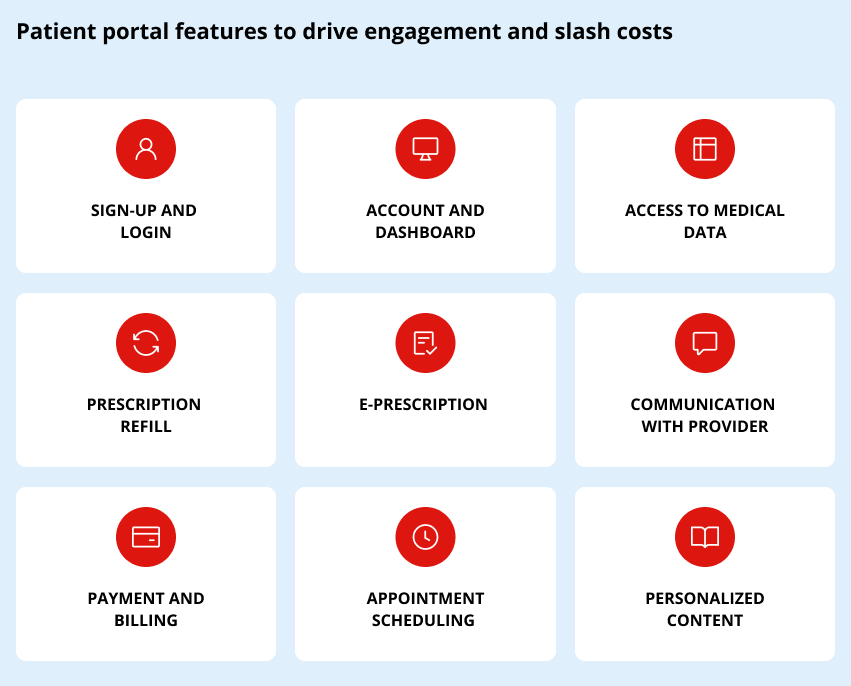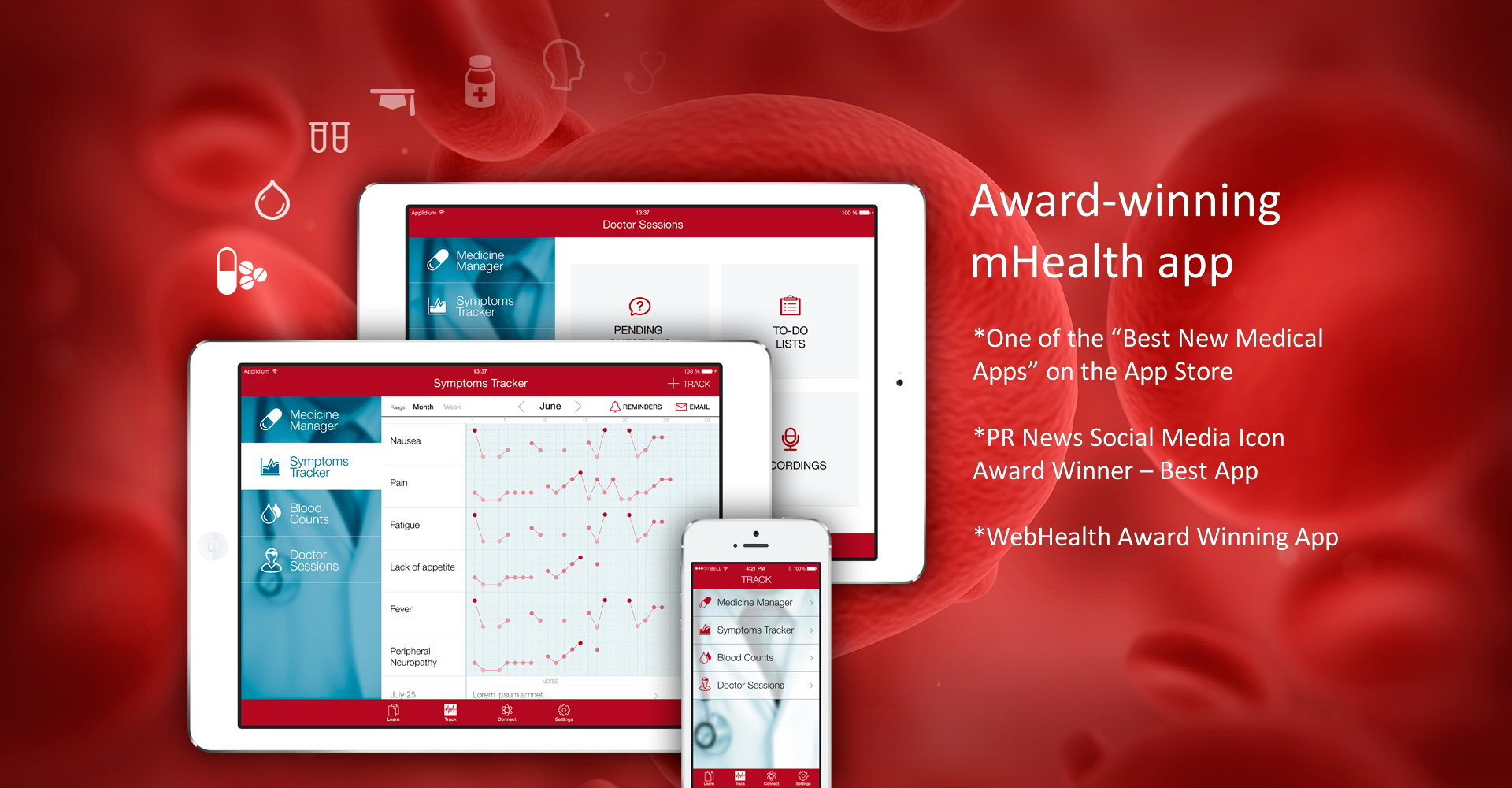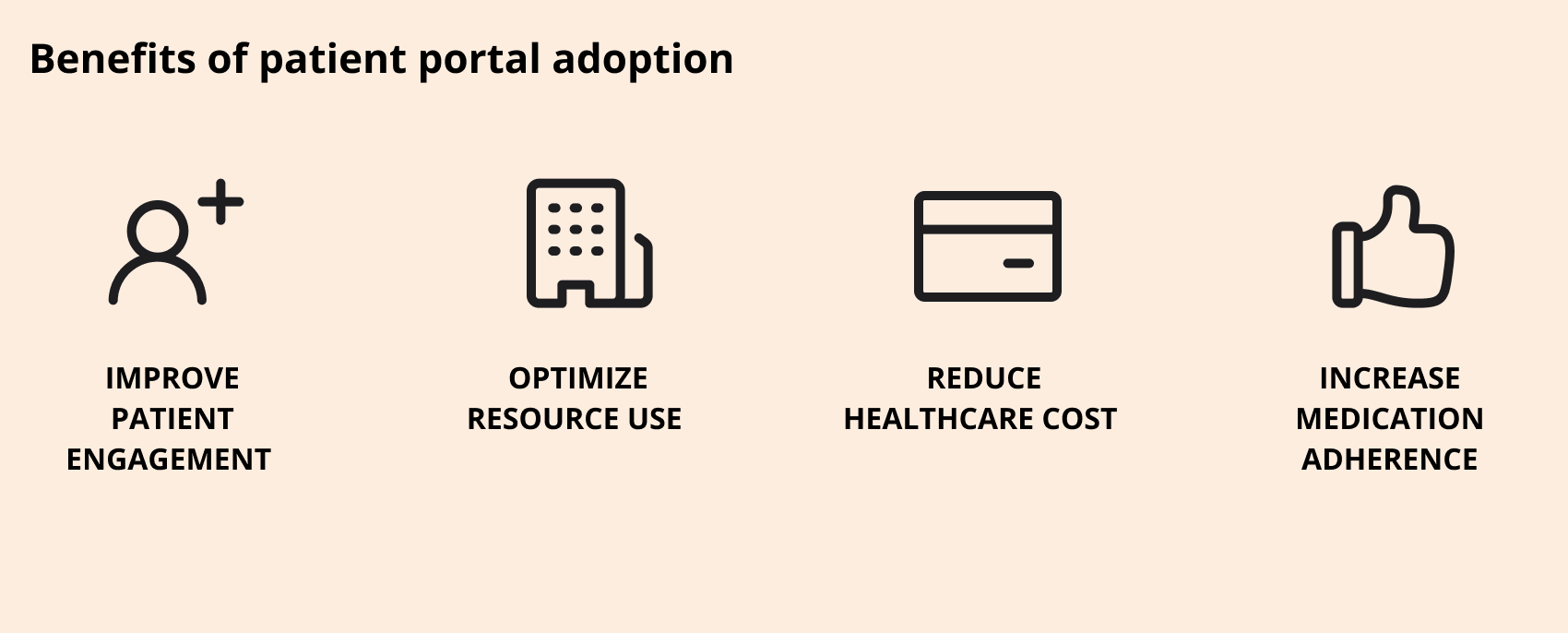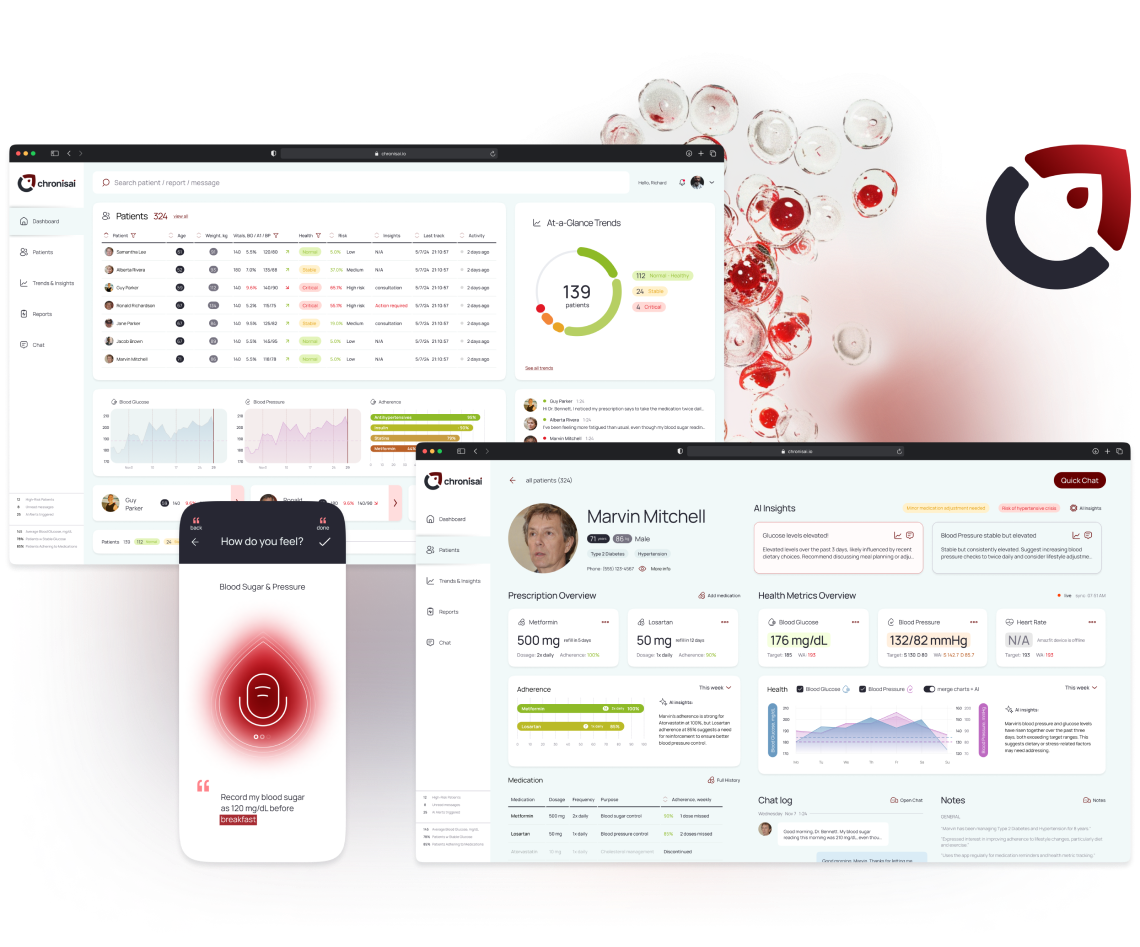7 Essential Features of Patient Portals
Successful healthcare outcomes rely on active patient engagement — like sticking to treatment plans, adjusting medication, and keeping up with regular check-ups. But it can be overwhelming without the right tools.
That’s where patient portal software comes in. It gathers health data in one place and makes it easy to interact with: check test results, book appointments, and reach out to a doctor — whether it’s a routine visit or an emergency.
For a patient portal to truly make a difference, it needs to have certain features. Some patient portal features drive engagement, others ensure patients show up, and some can help slash operating costs without compromising the quality of care.
In this quick 5-minute read on patient portal features and benefits, we’ll walk you through:
- The must-have features for every patient portal.
- Valuable features of portals for those with chronic diseases.
- How the right features can improve healthcare outcomes and reduce costs.
- A few essentials to remember before starting web portal development.
But before we get into the core features, a quick review of the role of patient portals in the modern healthcare space.
What is a patient portal and why is it a big deal in healthcare?
A patient portal is a web application that allows patients to easily access their medical data and services online. It gives users tools to carry out routine healthcare activities such as getting a prescription or scheduling doctor appointments online on any device. As a result, patients become active participants in their healthcare experience. This brings a whole host of benefits for patient outcomes and explains the rapidly-increasing popularity of portals.
In 2024, My Kanta, the Finnish patient portal, had 3.2 million users in a country of 5.5 million. With more than 70% of people in most age groups using it (except those under 18 and over 74), it’s a great example of how well a patient portal can work.
All patient portals can be divided into two groups: integrated and standalone.
Integrated patient portals
An integrated patient portal is a part of a larger healthcare solution, e.g. practice management software or EHR. It is seamlessly connected with other modules in the system enabling fast and secure circulation of data. These portals, however, may lack the flexibility and customization provided by their standalone counterparts.
Standalone patient portals
As the name implies, this patient portal is a standalone solution configured or custom-designed to address specific client needs or requirements. These applications can exist outside other systems within the organization (patient management software, EHR). Although, standalone patient portals can also be integrated into the in-house infrastructure via API on demand.
Create frictionless experience for all your patients
Develop a secure and compliant solution to boost engagement and drive operational efficiency.
Show patient portal servicesThere are a few key patient portal functions and features that you will find in nearly every application in this market.
- Access to health records and personal data
- Appointment scheduling
- Prescription request/refill
- Contact with healthcare provider/assistant
- Online payments/billing
- Access to medical content
Let’s look into the key features of web portals for patients in detail and see how they help improve patient engagement and overall healthcare experience.

Sign-up and login
Registration and secure access to medical data and services are the first key features of patient portals. Without them, a patient portal is just a general-use healthcare website.
Much like any other web portal, a patient portal must have strong security and authentication for sign-up and login. It is essential for personal data protection and HIPAA compliance. At the same time, registration and entry should be intuitive and take only a few clicks. Anything more complex than that may seriously affect the portal adoption rate. And you don’t want that.
Patient account and dashboard
Depending on the organization and type of portal, a patient account may have only a few data fields to fill. Or can be designed as a single feature-rich space where users get access to everything – from visit reports to daily diet recommendations. In most cases, account and dashboard allow patients to:
- Fill in/change personal information
- Access available medical data (health records, test results, examinations, vaccination reports, etc.)
- Access other features of a patient portal (prescription refill, online appointment, billing, etc.)
- Set up and change settings (notifications, privacy, etc.)
E-prescription
Online prescriptions and prescription refills are convenient for some patients and vital for others. This feature was a game-changer during the hardest months of the pandemic, especially for those with chronic diseases and the elderly who rely on regular medication. And it is just as relevant today.
The e-prescription module is often integrated with a cloud-based pharmaceutical database. This allows to deliver and access prescriptions in any connected pharmacy within minutes. Paired with medication reminders and monitoring, e-prescription becomes one of the most effective tools to increase medication adherence.
Appointments
Want to reduce no-shows? Give your patients the opportunity to schedule their appointments online and combine it with timely reminders. In fact, appointment scheduling is one of the most desired features of patient portals.
Availability for appointments is the top (44%) most important thing patients expect from healthcare providers, according to the survey by Redpoint Global.
Online appointments and interactive calendars make scheduling doctor visits easy and fast on any device. It saves patients from long phone calls and cuts out a large chunk of administrative work for your staff.
Telehealth

Instant chat and video consultations are common features of medical portals both for doctors and patients. And for a good reason. Telehealth helps create frictionless communication between patients and healthcare providers, reduces response time, and decreases the need for in-person hospital visits.
The best part? Integrating these features is less expensive and time-consuming than you may think. Modern communication platforms like Twilio allow to add video, audio, and text messengers to applications fast and cost-effectively.
Billing and payment
Online billing and secure payment give customers the flexibility to manage their healthcare expenses from anywhere. Along with fast and easy access, these features also bring transparency, allowing patients to keep track of their spending on medicals, outpatient care, as well as insurance coverage. As a provider, you will reduce the time and effort spent on medical billing and insurance management.
Personalized content
Educational content stands aside from other popular features of online portals for patients. This feature is particularly valuable for a certain category of customers such as patients with chronic conditions or those undergoing long-term treatment. The personalized educational content in this case serves as information support and helps boost participation and engagement among customers.
Example: When designing Focus on Lymphoma application for lymphoma patients, we added personalized educational content along with a comprehensive set of features – e-prescription, medication management, doctor-to-patient communication, and symptom tracking. It tailors content to the needs of users with different lymphoma subtypes at different stages of their journey, from recently diagnosed to undergoing treatment. The application quickly became the #1 place for getting verified relevant information for lymphoma patients (treatment and therapies options, clinical trial) and won several awards as The Best App and The Best New Medical App on App Store.

Other features to consider
Along with these essential patient portal features, you may look into other functions that support your patients’ lifestyles and routines. Consider health tracking and reporting, integration with wearables and medical IoT devices, as well as health insurance coverage and benefits checks.
We have briefly outlined how different features can benefit your customers and your practice. Let’s wrap it up:
Improve patient engagement
Widespread adoption of patient portals has proven to significantly boost patient engagement. Those who use portals highlight better communication with their care providers, the ability to track all their health data, as well as overall transparency of the healthcare process.
Optimize resource use
All features of a medical portal that we have mentioned one way or another lead to cutting waste and optimizing the use of healthcare resources and healthcare providers’ time. For example, telehealth and health tracking features reduce hospital visits and optimize the use of hospital space and doctor’s time. Self-check-ins, online payments, and scheduling decrease the load on staff enabling better time management, process automation, and more patient-centered care.

Reduce healthcare cost
As we said at the outset, active use of patient portals helps reduce hospital stays, potentially saving patients, healthcare providers and insurance agencies a ton of money. And this is only one saving point among many:
- Reduced supply and administrative costs
- Reduced labor costs
- Optimized facility management costs
- Reduced treatment costs
Increase medication adherence
E-prescriptions and prescription refills have been directly linked to improved medication adherence and self-care management across all groups of customers.
Comply with stringent regulations
Every healthcare software product – a patient portal, telehealth app, or EHR – must be designed and built with relevant regulations and laws in mind. These regulations are usually focused on the privacy and security of healthcare data. HIPAA (US), HITECH Act (US), PIPEDA (CA), and GDPR (EU) are just some of the most prominent examples. Local alternatives may also apply.
Focus on user-centered design and inclusivity
For some patients, online portal features may be hard to access and use. You should factor this at an early stage and figure out how to make the portal inclusive and accessible to all user groups, regardless of tech skills or physical limitations. Start with the user-centered design process to better understand your audience and their needs. You may also consider using accessibility features like text-to-speech, screen magnifier, typeface and font size adjustment, and language localization to create a better user experience for all your customers.
Personalization
Patient data is a goldmine of untapped potential. With data-driven personalization, your portal does more than just store info—it can guide users to the nearest clinic, recommend helpful content, and even adapt to their unique needs.
For example, a patient portal can make a real difference for people with chronic conditions or those undergoing long-term treatment. These patients face daily challenges that impact how they interact with technology, making some functions of patient portals harder to use.
When Digiteum worked on an AI-powered solution for diabetes and hypertension patients, we saw this firsthand. Diabetic neuropathy, which causes fingertip numbness and scarring, made touchscreen logging nearly impossible. Frustrated, many patients stopped using the portal, leaving doctors without reliable data.
Personalization was the fix. During the Discover phase, we identified the problem and built a solution: voice input. Instead of struggling with a touchscreen, customers could log meals just by speaking. The app converted speech to text using secure AI-powered tech, making nutrition tracking effortless. This small change made the portal truly work for those who needed it most.

Build a patient portal tailored to the needs of your audience while keeping the focus on your delivery timeline and budget.
We can help you design and develop a user-centered patient portal from scratch or speed up your ongoing project by adding senior tech specialists on demand.
Our expertise in this niche includes:
- 15+ years in eHealth and patient portal software development.
- Dozens of eHealth applications delivered for such clients as Takeda, Lymphoma Research Foundation, Diaceutics, MSD, OLVG, and NextGate.
- Rich experience in application development for pharma, clinics, medical device producers, and healthcare analytics companies.
- Award-winning medical application (Focus on Lymphoma, How Do I?).
- End-to-end web portal development services from discovery to launch.
Create a ridiculously easy-to-use patient portal
Make it fast and easy for your patients to access your services and become loyal customers for life.
HIRE PATIENT PORTAL DEVELOPERSQuick round-up
- Among many medical software development services, interest in patient portals is growing.
- The reason is that this instrument proved to make the healthcare experience significantly better and more efficient for patients and providers.
- There are several essential patient portal features that help drive engagement and improve outcomes, including e-prescription and online appointment scheduling.
- Knowing which features to choose and prioritize will help you design and develop an engaging patient-centric portal as well as improve your practice and cut operating costs.
This post was originally published on October 07, 2022, and updated on March 21, 2025.







